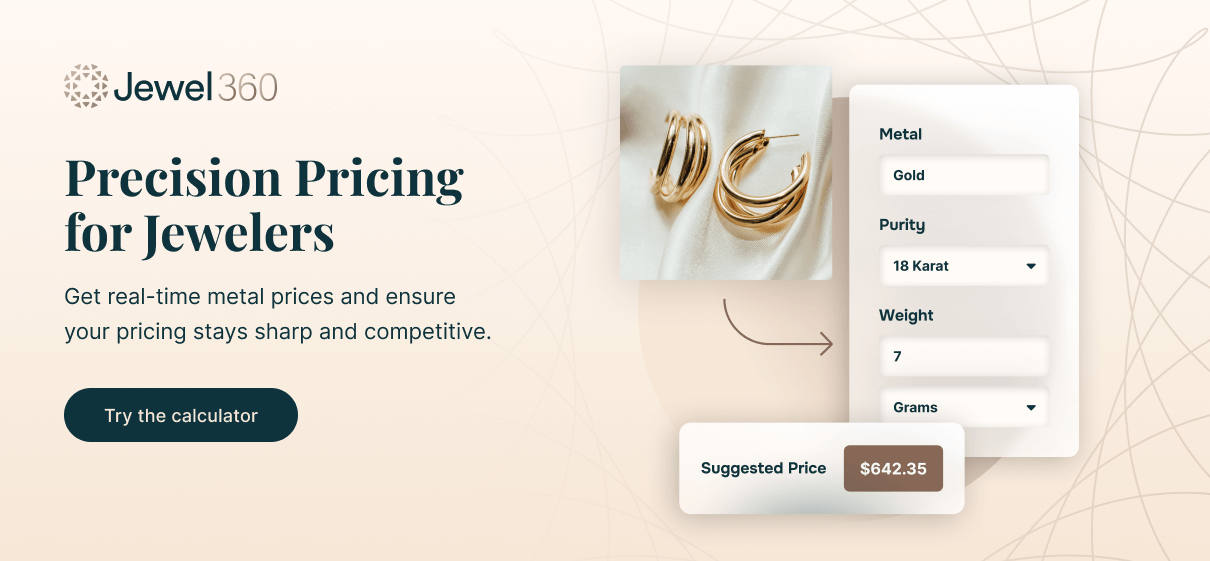
Have you ever wondered about each customer’s value to your jewelry store? When you know the lifetime value of your customers, it’s much easier to make decisions about how to invest in your marketing, inventory, and employees.
Customer lifetime value (CLV) represents the total revenue you can expect from a single customer account throughout your business relationship. Understanding this metric shows you the long-term value generated by a customer and highlights the importance of maintaining strong relationships with your customers.
Let’s dive deeper into what jewelry customer lifetime value is, how to calculate it, and why it’s a game-changer for jewelry store owners like you.
What Is Customer Lifetime Value?
Customer lifetime value predicts the net profit attributed to the entire future relationship with a customer. It considers both the revenue from a customer and the costs associated with acquiring and serving them.
By applying CLV, you can tailor your marketing efforts, improve customer retention strategies, and make informed decisions about resource allocation. Additionally, the CLV prediction can be very basic or highly advanced, depending on the methods used.
Principles of Customer Lifetime Value
Customer lifetime value can be a useful tool for any business. Here are a few principles that demonstrate how it can help your business make decisions:
- Resource allocation: CLV helps you gauge how much to invest in gaining and retaining customers. By knowing the potential revenue from a customer, you can better distribute your marketing and service resources.
- Customer retention: Understanding which customers bring the most value can guide retention strategies. You can concentrate on high-value customers to maximize profitability.
- Strategic planning: CLV gives you insights into customer behavior and preferences, which helps develop long-term strategic plans that align with customer needs and business goals.
- Profitability analysis: This allows you to figure out which customer segments are the most profitable, so you can focus on them. Customer segments are the groups that share characteristics like demographics, behaviors, needs, or preferences.
Related Read: How To Increase Jewelry Store Sales: 6 Actionable Tips
But how do you apply this in your jewelry store? For instance, with resource allocation, your store might invest more in marketing a high-value diamond collection to customers who have previously purchased engagement rings and are likely to buy again. You can also offer exclusive cleaning and inspection services to customers who have made significant purchases.
In strategic planning, recognizing that bridal jewelry buyers often come back for anniversary gifts can help guide your inventory decisions and marketing messages. For profitability analysis, you may find that customers who purchase custom-designed pieces have a higher lifetime value, leading you to focus on promoting those services.
How To Calculate Customer Lifetime Value
As you explore customer data further, prediction models can vary greatly in complexity and accuracy, ranging from basic rules of thumb to sophisticated predictive analytics. One simple formula for calculating customer lifetime value is:
Average purchase value x Average purchase frequency x Customer lifespan
Here’s a breakdown of the components:
- Average purchase value: Total revenue divided by the number of purchases
- Average purchase frequency: Total number of individual purchases divided by the number of unique customers
- Customer lifespan: The average duration a customer continues to purchase from the business
For a jewelry store, the average purchase value might be $500, the average purchase frequency might be two times per year, and the average customer lifespan might be five years.
Customer lifetime value: $500 x 2 x 5 = $5,000
By calculating CLV, you can predict future revenue streams and adjust your strategies accordingly to meet customer expectations.
Incorporating this into your business plan can significantly impact how you manage customer relationships and drive growth. It allows you to focus on long-term success rather than short-term gains, ensuring that your jewelry business remains profitable and competitive in the market.
Why Jewelry Customer Lifetime Value Is Important
Customer lifetime value is particularly important for jewelry stores like yours because it supports several key areas that directly affect your business’ success.
Targeted Marketing and Sales Strategies
Understanding the CLV allows you to segment your customer base effectively. By identifying which customers — like custom jewelry buyers — are likely to bring in the most value over their lifetime, you can tailor your marketing campaigns to target these specific segments.
This means distributing more resources to high-value customers through personalized marketing messages, special offers, and loyalty programs. By doing so, you maximize your marketing return on investment (ROI) and ensure that your sales strategies are aligned with the most profitable customer segments.
Related Read: The Challenges of Selling Jewelry (+ 5 Tips To Overcome Them)
Customer Retention
In the jewelry industry, retaining customers is often more cost-effective than gaining new ones. CLV gives you insights into which customers are worth retaining due to their potential long-term value.
By focusing on customer retention strategies like loyalty programs, personalized follow-ups, and exceptional customer service, you can increase the chances of repeat purchases. To excel at customer service, implement a clienteling program in your store and follow up with new pieces and collections that appeal to your best customers.
Strategies like these can boost sales and enhance customer satisfaction, which leads to a stronger brand reputation and increased word-of-mouth referrals.
Inventory and Product Planning
With insights from CLV, you can make informed decisions about your inventory and product offerings. By understanding the purchasing patterns and preferences of high-value customers, you can stock items that are more likely to attract them.
This reduces excess inventory, minimizes waste, and ensures that your jewelry store is equipped with products that meet customer demand. You can also introduce new product lines or exclusive collections, like a limited-edition diamond assortment, that cater specifically to the tastes of your most valuable customers, further enhancing their shopping experience.
Related Read: Gems Inventory Management 101 (+ 7 Best Practices)
Personalized Customer Experience
High CLV customers often expect a personalized and memorable shopping experience. By leveraging CLV data, you can offer tailored services like personalized jewelry consultations, custom design options, and exclusive access to new collections or events.
These personalized experiences make customers feel valued and appreciated, motivating them to continue shopping with your store — ultimately boosting satisfaction and fostering long-term loyalty and advocacy for your brand.
Financial Forecasting and Business Growth
CLV is a helpful tool for financial forecasting and strategic planning. By predicting future revenue streams based on CLV, you can make data-driven decisions about budgeting, resource allocation, and business expansion. It can allow you to set realistic growth goals and develop plans to achieve them. Understanding CLV helps you cut costs and improve daily processes, too.
Competitive Advantage
In the crowded jewelry market, gaining a competitive edge is important for success. By focusing on CLV, you can attract high-value customers and encourage them to stay loyal to your brand. As a result, you build a strong reputation and increase your market share, positioning your store as a leader in the industry.
By expanding on these key points, you can see how customer lifetime value serves as a powerful tool.
Maximize Your Jewelry Store’s Customer Lifetime Value With Jewel360
To achieve long-term success for your business, it’s important to understand and optimize customer lifetime value.
Focusing on the following key areas strengthens the profitability and sustainability of your jewelry store:
- Targeted marketing
- Customer retention
- Inventory planning
- Personalized experiences
- Financial forecasting
Jewel360 can be an invaluable tool in this journey. With its comprehensive features, our all-in-one point of sale (POS) software helps you effectively track and analyze customer data, manage inventory, and tailor marketing strategies.
Some essential features that help calculate and improve CLV include:
- Customer tracking & history: Get a deeper understanding of customer behavior and purchasing patterns, allowing you to identify high-value customers and tailor your services accordingly.
- Marketing tools: Use email marketing and loyalty programs to engage, incentivize, and retain customers.
- Inventory management: Optimize stock levels and meet customer demand effectively.
- Built-in customer reports: Have access to various reports that give insights into sales trends, customer purchases, and financial performance.
Learn more about how Jewel360 can transform your business. Schedule a demo today to see how it can help you maximize your jewelry store’s customer lifetime value.




.png?width=101&height=101&name=Group%201%20(1).png)







 by Nick Gurney
by Nick Gurney

